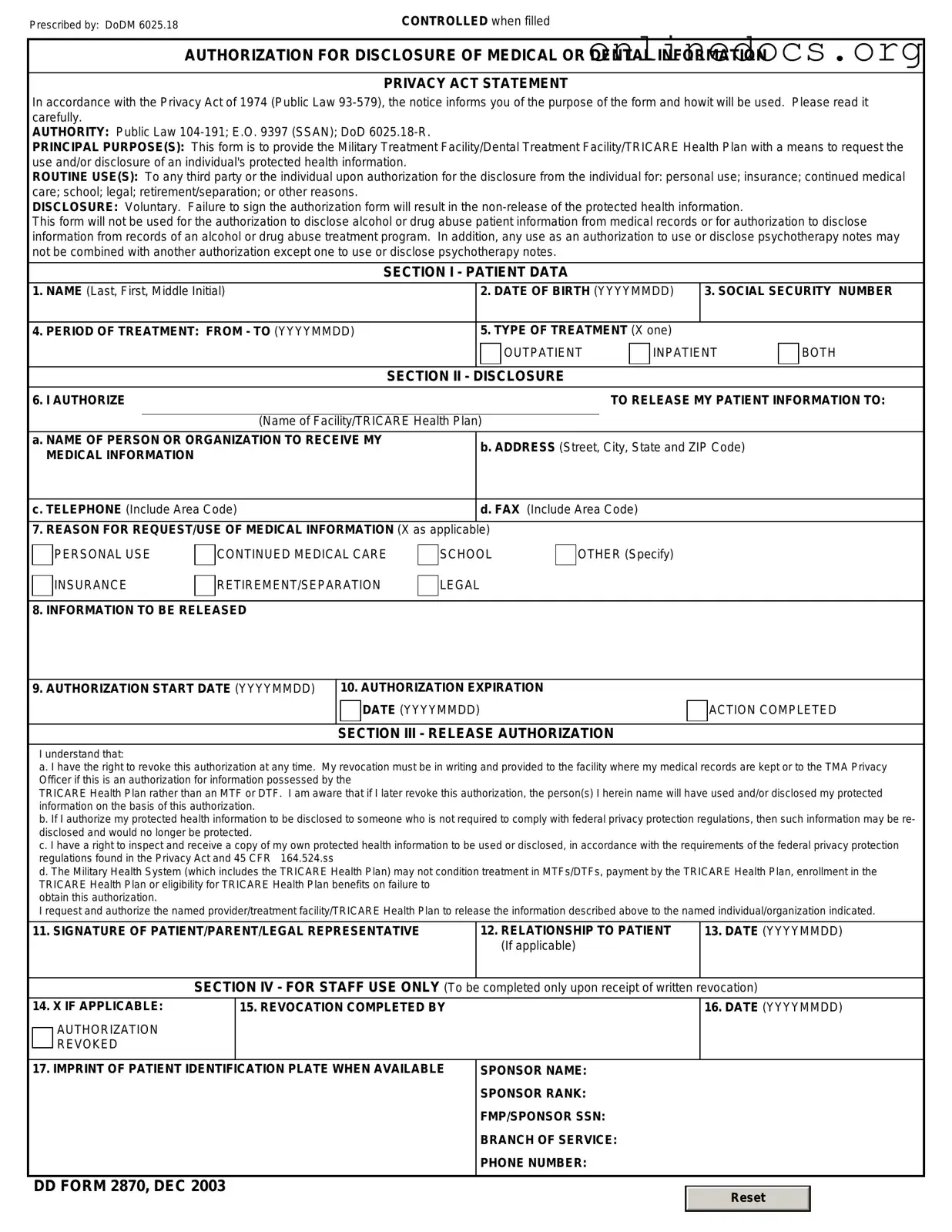The DD 2870 form, known as the Authorization for Disclosure of Medical or Dental Information, shares similarities with the HIPAA Release Form. Both documents are designed to allow individuals to grant permission for healthcare providers to share their medical information with designated parties. The HIPAA Release Form is specifically governed by the Health Insurance Portability and Accountability Act, which ensures that personal health information remains confidential while allowing for necessary disclosures. Like the DD 2870, the HIPAA Release Form requires the individual’s signature and specifies the information to be shared, the purpose of the disclosure, and the duration of the authorization.
Another document akin to the DD 2870 is the Patient Authorization Form. This form serves a similar purpose in that it enables patients to authorize their healthcare providers to release medical records to third parties, such as family members or other medical professionals. The Patient Authorization Form typically includes sections for the patient's identification, the information being released, and the recipients of that information. Both forms emphasize the importance of informed consent and the right of individuals to control who accesses their medical data.
The Release of Information Form is also comparable to the DD 2870. This document is commonly used in various healthcare settings to facilitate the sharing of patient information. It allows patients to specify what information can be disclosed and to whom. Like the DD 2870, the Release of Information Form must be signed by the patient, ensuring that the process is transparent and that patients understand their rights regarding their medical information.
The Consent to Treat Form bears some resemblance to the DD 2870 as well. While its primary function is to obtain consent for medical treatment, it often includes clauses that allow for the sharing of medical information relevant to the treatment process. Patients must sign this form to indicate their understanding of the treatment and the associated risks, similar to how they must authorize the release of information on the DD 2870.
The Authorization for Use or Disclosure of Protected Health Information is another document that aligns closely with the DD 2870. This authorization form is specifically designed for use in accordance with HIPAA regulations. It outlines what health information can be shared, with whom, and for what purpose. Both forms require clear and informed consent from the patient, emphasizing the importance of patient autonomy in healthcare decisions.
For those interested in vehicle transactions, understanding the Motor Vehicle Bill of Sale is vital. This document formalizes the sale process and provides essential protection for both buyers and sellers. To find out more about this important form, visit this comprehensive Motor Vehicle Bill of Sale resource.
The Medical Records Release Form is also similar to the DD 2870. This document is specifically utilized for the purpose of obtaining copies of medical records from healthcare providers. Patients fill out this form to authorize the release of their records to other healthcare facilities or individuals. Just like the DD 2870, the Medical Records Release Form ensures that patients are aware of their rights regarding their health information and the implications of sharing it.
The Consent for Release of Information Form is yet another document that serves a similar function. This form allows patients to consent to the release of their medical information to specific individuals or organizations. It typically requires detailed information about the patient, the type of information being released, and the intended recipients. Both the Consent for Release of Information Form and the DD 2870 prioritize the patient's right to control their personal health information.
Lastly, the Authorization for Release of Educational Records, while primarily focused on educational information, shares a similar framework with the DD 2870. This form allows students or parents to authorize the release of educational records to third parties. Like the DD 2870, it requires clear consent and specifies what information can be shared, demonstrating the broader principle of personal data control across various contexts.
